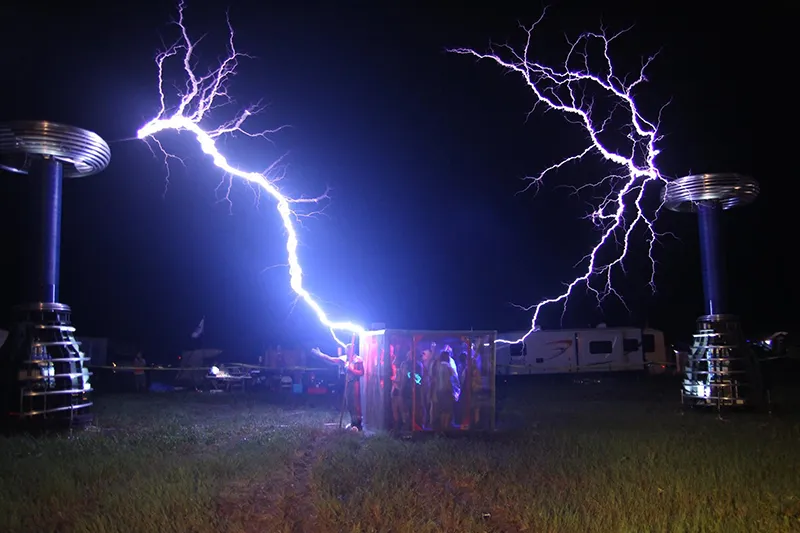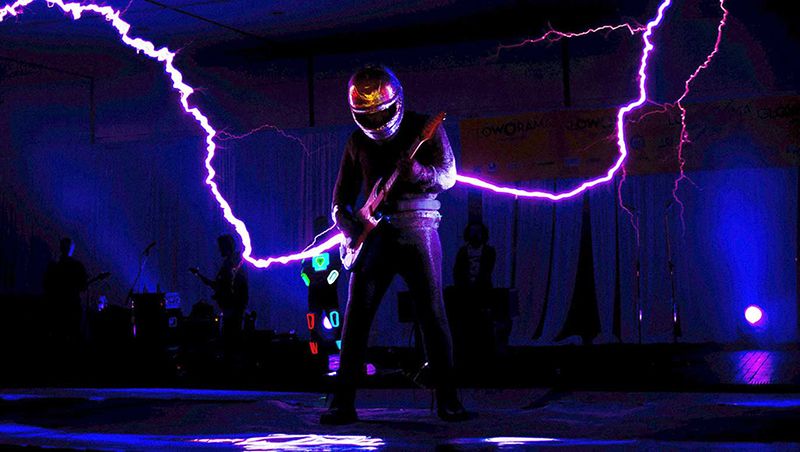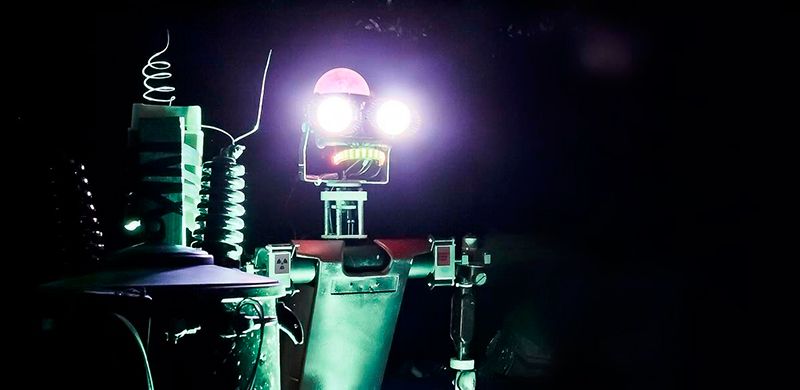When Electricity and Music Collide, the Tesla Coils Sing
The band ArcAttack delivers a high-voltage performance with a side of science education
:focal(434x331:435x332)/https://tf-cmsv2-smithsonianmag-media.s3.amazonaws.com/filer/8d/c1/8dc176c1-31f3-422b-b410-3d18ae2a0b81/arcattack-rockinguitar.jpg)
The reverberations of the announcer's amplified voice fade into the darkened auditorium, and the last few cheers from the crowd are cut off by a sizzling buzz. In the center of the stage, awash in blue and purple light, a figure steps forward. Helmeted like a knight, draped in what appears to be chain mail and wielding an electric guitar, the figure plays the first few crackling chords of his set. As he does so, forked tongues of lightning reach out from two towers flanking the stage and strike him. But he doesn’t even flinch.
This overpowering display is a typical performance for the Austin, Texas-based group called ArcAttack. The guitar player's dancing fingers might control the music, but the notes themselves come from the bolts let loose by the twin towers.
"I think that is the hardest thing to convey to people who don't see it in person," says Joe DiPrima, one of the founding members of ArcAttack and frequently the man playing the lightning guitar. "The electrical arcs are vibrating the air and creating sound waves."
The towers are giant Tesla coils, named after for the Serbian-American who invented them in 1891. Nikola Tesla created his Tesla coil as part of a quest to generate and transmit electricity wirelessly. He was also an eccentric character with a flair for showmanship, part of the reason that his story continues to intrigue people today. More than a century later, ArcAttack's Tesla coil-powered performances still have a decidedly futuristic feel, a trait that has earned them an invitation to light up the stage at the Smithsonian magazine's “Future is Here” festival on April 23.
ArcAttack doesn't just perform to impress—though there is no doubt that audiences love their techno-wizardry. They have appeared on “America's Got Talent" and powered a stunt by magician David Blaine. But in between such high-voltage appearances, ArcAttack tours the country giving shows and educational presentations for school groups and the general public, dazzling people while also explaining the science behind their show. "The best thing we can do is to make [the audience] curious," says DiPrima. "So they will go home and look into it more."
To understand how ArcAttack's singing Telsa coils work, it's best to start with the definition of a Tesla coil. DiPrima calls his group's singing Telsa coils "upgrades" of Tesla's original design because they use solid-state transformers and other electrical parts that weren’t available in Tesla’s time. But much of the basic idea is still there. These devices essentially act like electrical tuning forks, meaning they store electrical energy by oscillating at their natural resonant frequency. More specifically, the circuits in the devices contain an inductor—an electrical component that resists changes in the electrical current—and a capacitor—an electrical component that stores energy.
These so-called resonant Tesla coils each have two coils, a primary and a secondary. The devices first take power from a wall socket and step up the energy by switching the current back and forth between the inductor and capacitor components of the primary coil. The secondary coil is tuned to the same resonant frequency as the primary coil, so once the primary gets up to speed, the two coils can exchange energy back and forth.
The result of that oscillation is high-voltage, high-frequency energy that gets stored in the donut shape that lives at the top of the device’s tower, a structure called a “torus.” ArcAttack’s Tesla coils can put half a million Volts into the torus. Then they funnel that energy through another inductor to control the current and produce massive sparks. ArcAttack's giant coils can generate sparks that stretch 12 feet long.
While that energy output is still far below the 100 million Volts contained in even the weakest bolts of lightning, it is enough to require expert operators. "Just like pyrotechnics, the sparks are dangerous," says DiPrima. "The coils are just as safe as the people operating them."
Safety is a priority for ArcAttack. That's why the performer playing the lightning guitar (a duty shared by several group members) must wear a special outfit called a Faraday suit. This suit is named after Michael Faraday, another historical figure who experimented with electricity. It's no accident that the suit looks like chain mail. It is made of many links of metal that conduct electricity around the wearer's body rather than through it. That design makes the suit weigh about 30 pounds. The discomfort is surely worth the protection it gives when the sparks are flying. "For the most part you can't even tell that [electricity is hitting you]," says DiPrima. "You can only tell because you can feel some air moving around your fingertips." The most the wearer might feel is some static-like zaps.
With a background in electronics repair and experience playing a guitar since he was 14, DiPrima was the impetus behind making the Tesla coils sing. More than a decade ago, he saw a Tesla coil setup where a user could fiddle with dials to modulate the pitch and volume of the sounds coming from the coils. That was when he decided to create music with Tesla coils.
The singing part of ArcAttack's custom-designed coils takes the technology one step farther. Using a MIDI controller and logic boards like those found in a computer, DiPrima and his band mates can precisely control the timing of the resonance between the coils. The control lets the coils resonate for a few cycles before stopping them. A single event like this disturbs the atmosphere around the coil enough that it produces an audible popping noise. Precisely timing the on-off of the coils' cycling manipulates those pops so it sounds like a note, and stringing together a bunch of notes makes a melody. The group controls the coils' singing using either a modified electric guitar or a keyboard.
Together with a drum kit played by a robot, ArcAttack's members play original electronic compositions and covers of songs that would warm any geek's heart. The theme songs from Doctor Who and the movie Pacific Rim, and the "Imperial March" from Star Wars are just a few examples. While the members include a rotating cast of characters from the Austin area and beyond, the group mainly involves DiPrima; his brother John who plays the role of main composer; and Andrew Mansberger who plays keyboard and writes songs.
What might attendees to the Future is Here festival see when ArcAttack takes the stage? When I spoke to DiPrima, the group was still finalizing their set list but he did know one thing for certain: "There will be lightning," he says.
Tesla probably would approve.
ArcAttack will perform at Smithsonian magazine's “Future is Here” festival at Shakespeare Theatre's Sidney Harman Hall in Washington, D.C. To watch it LIVE, join us on Facebook this Saturday, April 23, at 5 p.m. EST. Keep up with the group's show schedule on their website and watch fun experiments on their YouTube channel.




